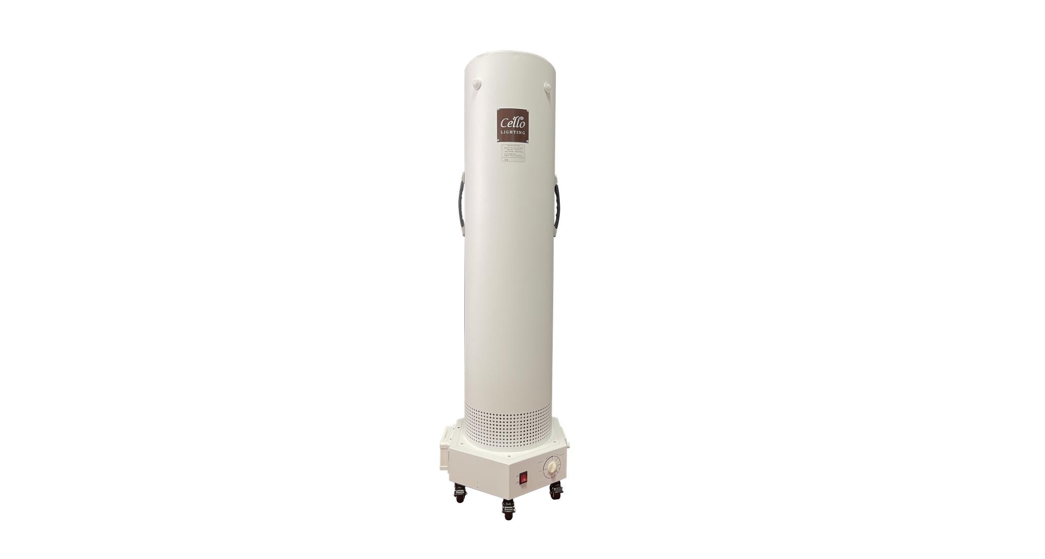CELLO OMNI4-IN-1 300WUSER MANUAL 
ANYTIME, ANYWHERE, BY ALL MEANSCello OMNI integrates UVC Surface Disinfection, UVCAir Disinfection, HEPA Filtering, and Needlepoint Bipolar Ionizers (NPBI) into one single product. With the blessing of IoT (Internet of Thing) technology to allow remote scheduling, control, and working log over the Cello Cloud. Cello Lighting, Inc. Palo Alto, CA 94303
Cello Lighting, Inc. 888-588-8849 customer_[email protected]
User Manual of Cello OMNI 4-in-1 300W
Overview
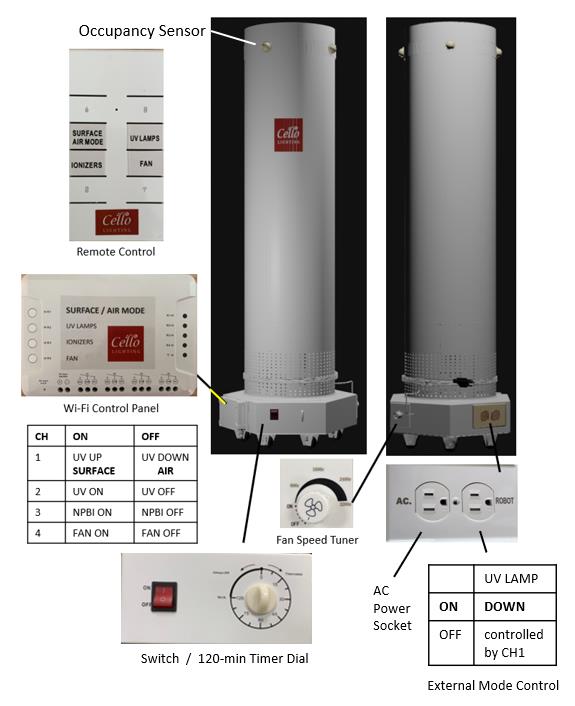
Disinfection Guidelines
Surface Mode UVC Disinfection
| Area | 400 sq. ft. | 800 sq. ft. | 1200 sq. ft. | 1600 sq. ft. | 2400 sq. ft. | 4800 sq. ft. |
| Time* | 10 min | 20 min | 30 min | 40 min | 60 min | 120 min |
*Suggested time to operate for 99.9% disinfection rate.** The UVC cart needs to navigate around the area to achieve the claimed disinfection rate.
Air Mode UVC Disinfection
| CFM | Disinfection | 500 sq. ft.* | 1000 sq. ft | 2000 sq. ft. | 4000 sq. ft. | 5000 sq. ft. |
| 200 | 100.00% | 20 min** | 40 min | 80 min | 160 min | 200 min |
| 400 | 99.99% | 10 min | 20 min | 40 min | 80 min | 100 min |
| 600 | 99.95% | 7 min | 14 min | 27 min | 54 min | 68 min |
| 800 | 99.90% | 5 min | 10 min | 20 min | 40 min | 50 min |
| 1000 | 99.80% | 4 min | 8 min | 16 min | 32 min | 40 min |
* Height = 8 ft. tall.** Time to exchange 100% of air.
Technical Specifications
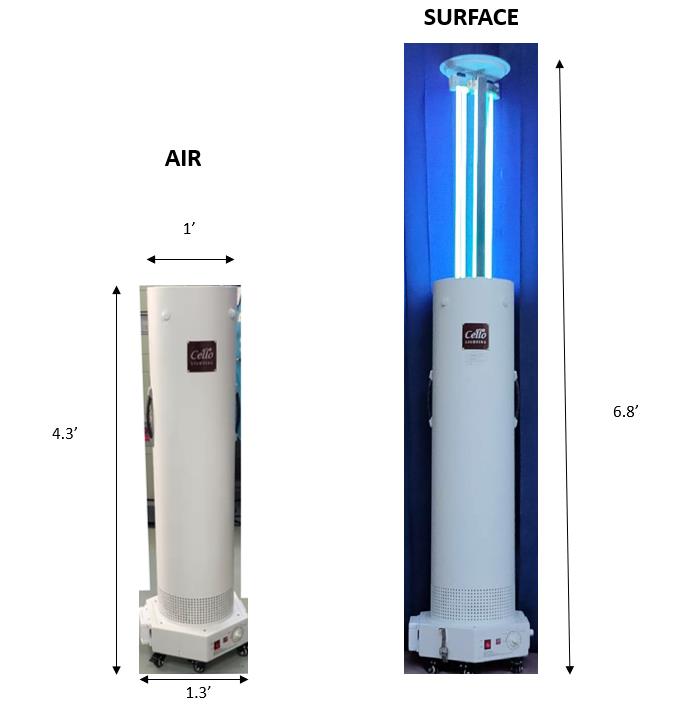
| Model | Parameter | Value |
| GENERAL | Input Watt | 120 V, 47Hz – 60Hz, 300W |
| Dimensions & Weight | 1.3′ (D) x 6.8′ (H) & 47 lb. | |
| UVC SURFACE | UVC wavelength | 253.7nm |
| UVC Irradiation | 630 RW/cm2 | |
| UVC AIR | SARS-CoV-2 Killing Rate | 99.9 % (@800CFM) |
| ACH @ 8 ft. high room of 1000 sq. ft. | 10 minutes (@800CFM) | |
| AIR EXCHANGE RATE (ACH) | 100-1000 CFM (continuously tunable) | |
| Ambient Noise | 50 dB (200CFM) — 65 dB (800CFM) | |
| HEPA | ASHARE MERV Value | MERV 13 |
| NPBI | Ion Concentration | 60 million ions per cubic cm per second |
Quick Start Guide
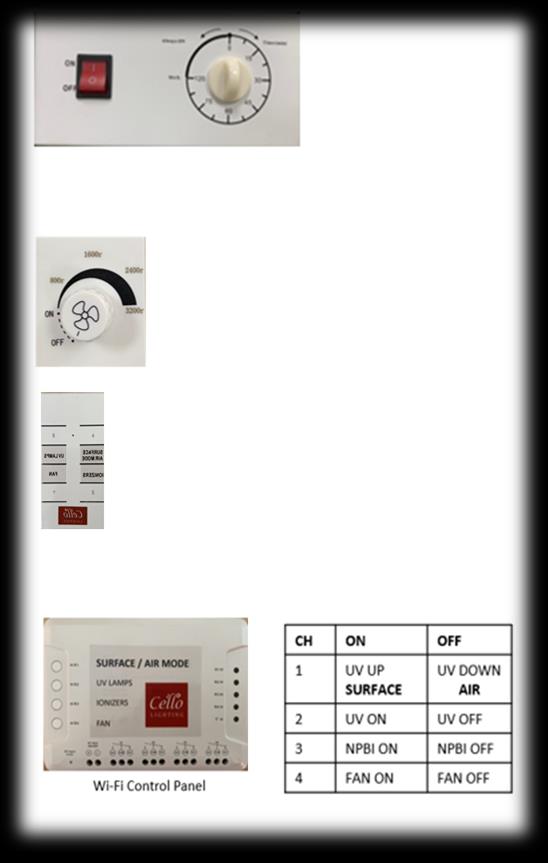
1. Turn on Power Switch2. Turn the Timer Dial to “Always On” (or 1-120 minutes)3. Tune Fan Speed4. Hold remote to control the Wi-Fi Panel:5. Turn on CH2 (Turn on UVC lamps)6. Turn on CH3 (Turn on NPBI)7. Turn on CH4 (Turn on FAN)8. Turn on CH1 to enter SURFACE Mode (UV lamps UP)9. Turn off CH1 to enter AIR Mode (UV lamps DOWN)
Cello Cloud Services (CelloVira.com)
In order to enjoy the powerful Cello Cloud Services at CelloVira.com, please do the following: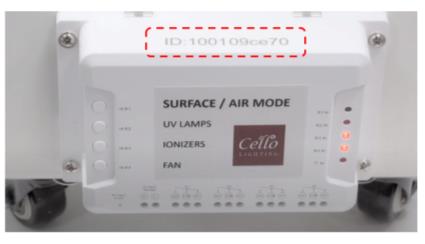 1. Identify the APP ID on your Cello OMNI.2. Email your APP ID to: SUBJECT: APP ID = 100109ce70 (your own ID)CONTENT: Contact NameOrganization NameAddressPhone Number3. Once you received your user/password, follow instructions to connect Cello OMNI 4-in-1 toInternet through your existing Wi-Fi networks:
1. Identify the APP ID on your Cello OMNI.2. Email your APP ID to: SUBJECT: APP ID = 100109ce70 (your own ID)CONTENT: Contact NameOrganization NameAddressPhone Number3. Once you received your user/password, follow instructions to connect Cello OMNI 4-in-1 toInternet through your existing Wi-Fi networks: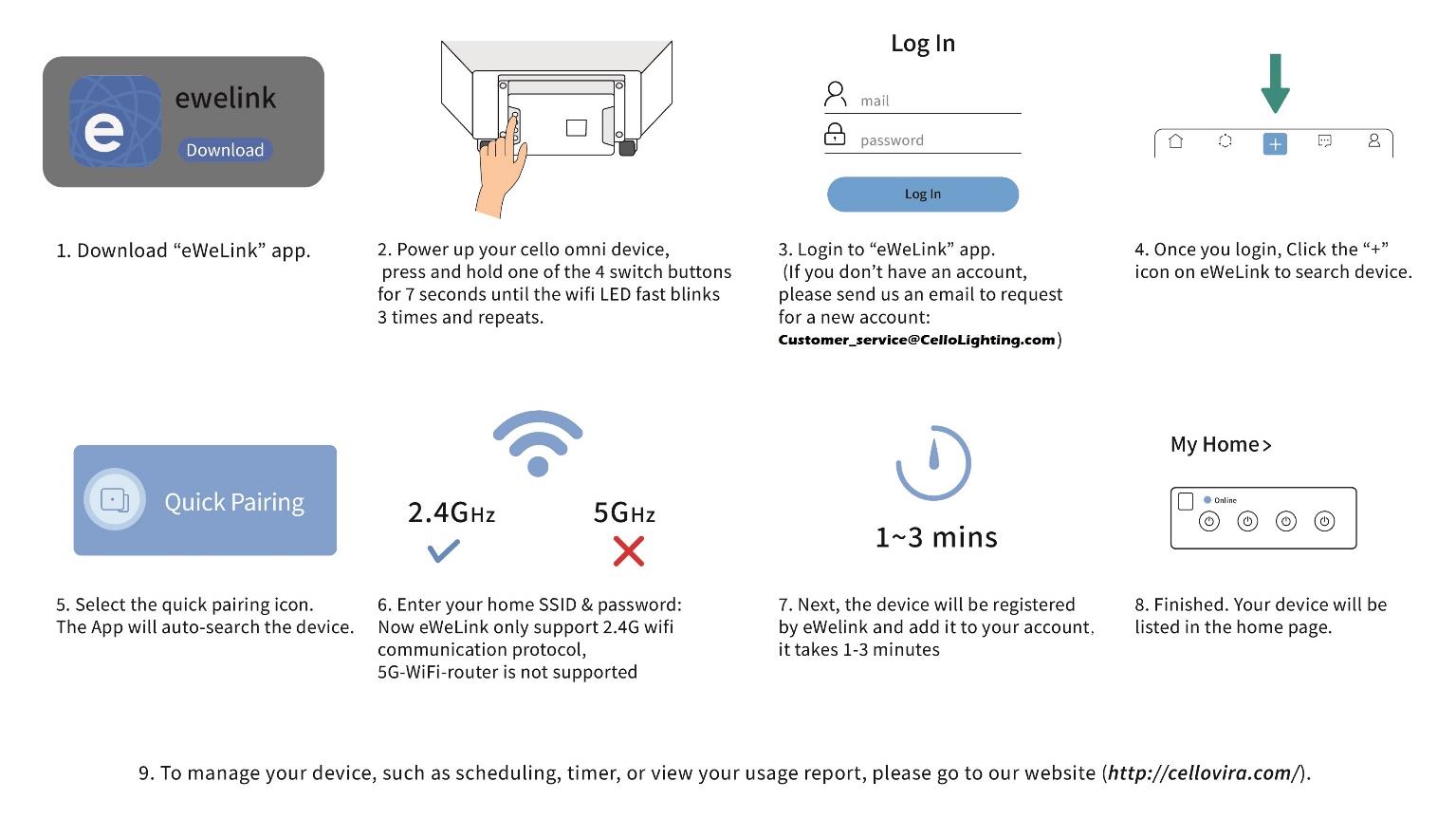
Use your new CelloVira USER/PASS to log in at: CelloVira.com Once logged in, you will see the following home page:
Once logged in, you will see the following home page:
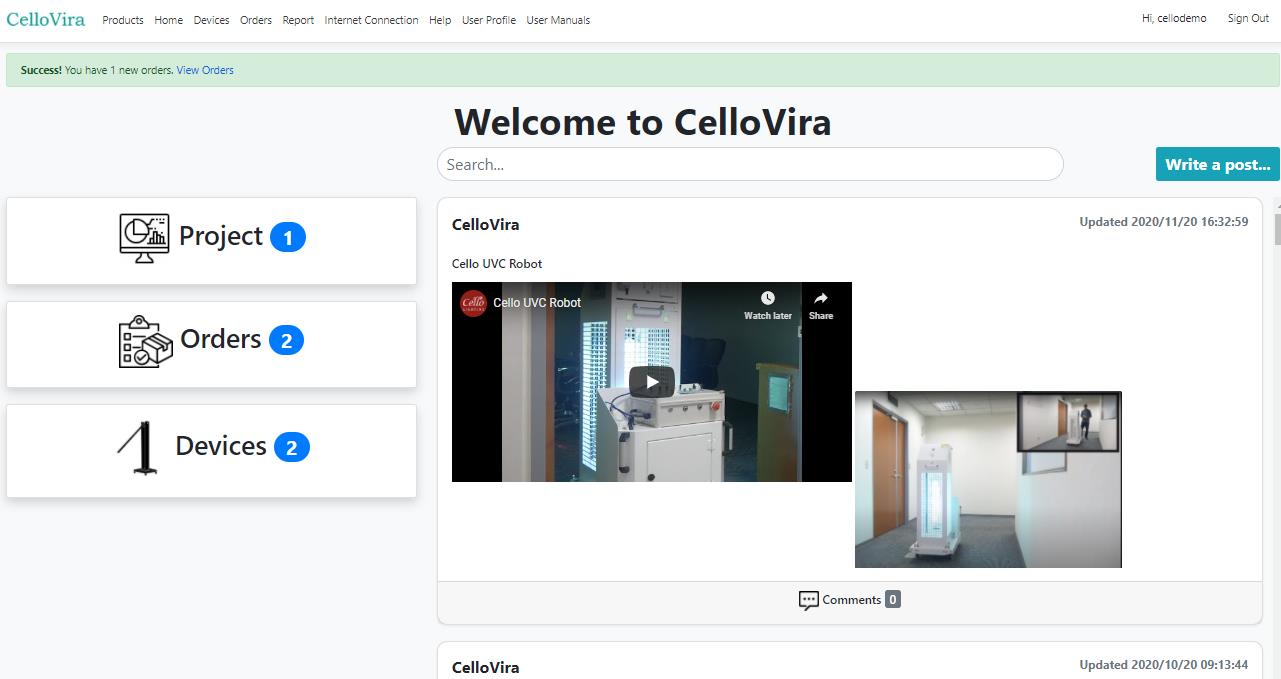
The top Menu includes the following:Products: Specifications sheets of ProductsDevices: Managing your Cello UV devicesUser Profile: Update your profileUser Manuals: User manuals of Cello UV products.
Scheduling of Cello OMNI Disinfection
Please visit CelloVira.com, log in the portal with your USER/PASS.Then Click <DEVICES>

Click <Group Name>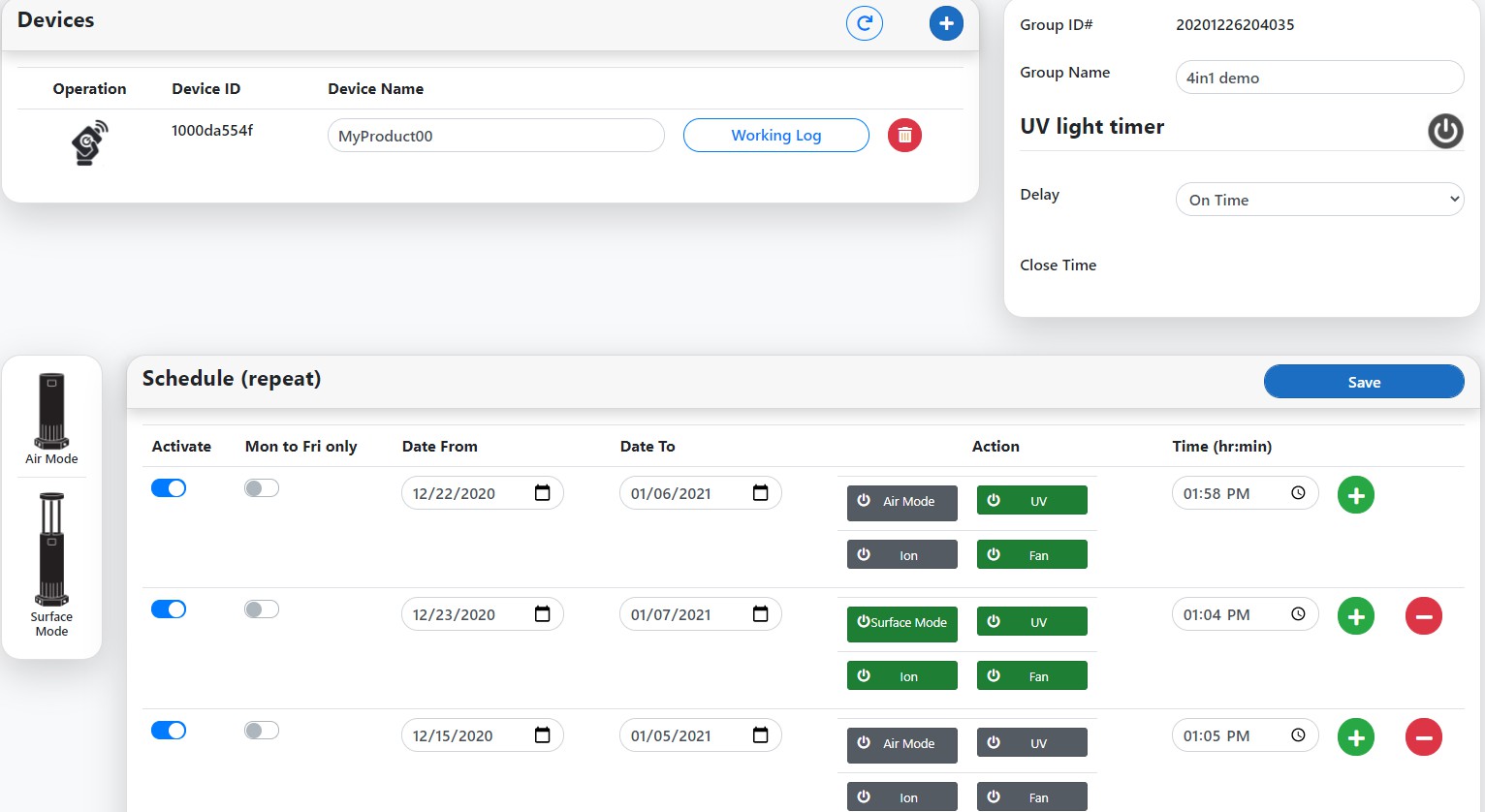 For instance, in this example:
For instance, in this example:

Cello OMNI status at 01:04 PM is: (Valid from 12/22/2020 to 01/06/2021)CH1 has turned ON: SURFACE MODE (Lamps are UP)CH2 is turned ON: UVC Lamps ONCH3 is turned ON: ION ONCH4 is turned ON: FAN ONCello OMNI status at 01:58 PM is: (Valid from 12/23/2020 to 01/07/2021)CH1 is turned OFF: AIR MODE (Lamps are DOWN)CH2 is turned ON: UVC Lamps ONCH3 is turned OFF: ION OFFCH4 is turned on: FAN ON
Safety Instructions
Surface Mode: Safe Tips
What are UV-C Disinfection Lamps?UV-C disinfection lamps emit radiation in the UV-C portion of the ultraviolet (UV) spectrum, which includes wavelengths between 100 and 280 nanometers (nm). The lamps are used in a variety of applications where disinfection is the primary concern, including air and water purification, food and beverage protection, and sterilization of sensitive tools such as medical instruments. Germicidal light destroys the ability of bacteria, viruses, and other pathogens to multiply by deactivating their reproductive capabilities. The average bacteria may be killed in 10 seconds at a distance of 6 inches from the lamp. The wavelength with the greatest effectiveness is 253.7 nm, which defines the germicidal lamp category with optimized wavelength for maximum absorption by nucleic acids.
Hazard and Risks from UV-C Disinfection Lamp RadiationUV-C radiation (UVR) used in most disinfection bulbs is harmful to both skin and eyes.UVR is not felt immediately; in fact, the user may not realize the danger until after the exposure has caused damage. Symptoms typically occur 4 to 24 hours after exposure.
The effects on the skin are of two types: acute and chronic. Acute effects appear within a few hours of exposure, while chronic effects are long-lasting and cumulative and may not appear for years. An acute effect of UVR is redness of the skin called erythema (similar to sunburn). Chronic effects include accelerated skin aging and skin cancer.
UVR is absorbed in the outer layers of the eye – the cornea and conjunctiva. Acute overexposure leads to painful temporary inflammation, mainly of the cornea, known as photokeratitis. Subsequent overexposure to the UV is unlikely because of the pain involved. Chronic exposure leads to an increased risk of certain types of ocular cataracts.
Working unprotected for even a few minutes can cause injury. It is possible to calculate the threshold for acute effects and to set exposure limits. It is not possible, however, to calculate the threshold for chronic effects; therefore, because no exposure level is safe, exposure should be reduced as much as possible.
10 CFR 851 mandates the use of the threshold limit value (TLV) exposure limits established by the American Conference of Governmental Industrial Hygienists (ACGIH). The exposure limit for a germicidal lamp is 6 millijoules per square centimeter. At this level, detectable molecular damage appears to be fully repaired within 24 hours. For the case of continuous exposure for longer than 8 hours, special care needs to be taken.
Do not remove the cover of the AIR unit when the power is onDue to the potential danger of UVC, do not remove the cover of this machine when the power is on.06/16/2020
Air Mode: Tips to Replace the HEPA FilterThe current pandemic has raised awareness and questions centered around best practices to follow forair filter replacement. Here are some recommended steps to replace an air filter:
1. TURN OFF THE POWER for safety. Also, turn off any fans in the area at least 20 minutes prior to servicing a filter.2. Wear personal protective equipment (PPE): This includes a face mask, nitrile gloves, and shoe covers.3. Remove the old filter. Simply slide it out of the slot that holds it in place.4. Check the condition of the filter. Does it look clogged with dirt and dust? Many factors can impact how fast a filter will become clogged, shortening the life of the filter.5. Replace the filter. Immediately place the old filter into a plastic bag being careful not to shake or drop it. Sudden movements can cause microscopic particles to be released into the air. Twist or tie the bag shut and consider taping it to create a seal.NOTE: If the filter has a permanent frame, the media should be removed outside. Be sure to dispose of the old filter in an outdoor trash can.6. Insert the new filter right away. An arrow on the filter’s frame shows the direction that air should flow through the filter, which is always away from the return air duct and toward the air handler mechanism. When inserting the filter back in the housing, make sure that the arrow points away from the return and toward the air handler. Write down the date you replaced the filter.
To maintain healthy breathable indoor air, standard HVAC air filters should be changed at least every three months. In some situations, the filter may need to be changed more frequently. Changing an air filter on a regular maintenance schedule also keeps equipment in top working condition, prevents breakdowns, reduces energy consumption, and limits expensive repairs.
Extra safety cushion provided by the internal UVC lampsThe HEPA filters in this AIR Unit are irradiated continuously by the UVC lamps above the HEPA filters. So, in general, most of the dangerous pathogens trapped on the HEPA filters have been inactivated before the technicians replace the HEPA filters. However, the UVC light can not penetrate the dust and particles, so if some pathogens are hidden underneath the dust and particles and were not irradiated by the UVC light, they might still be dangerous to technicians.
References
[xyz-ips snippet=”download-snippet”]

